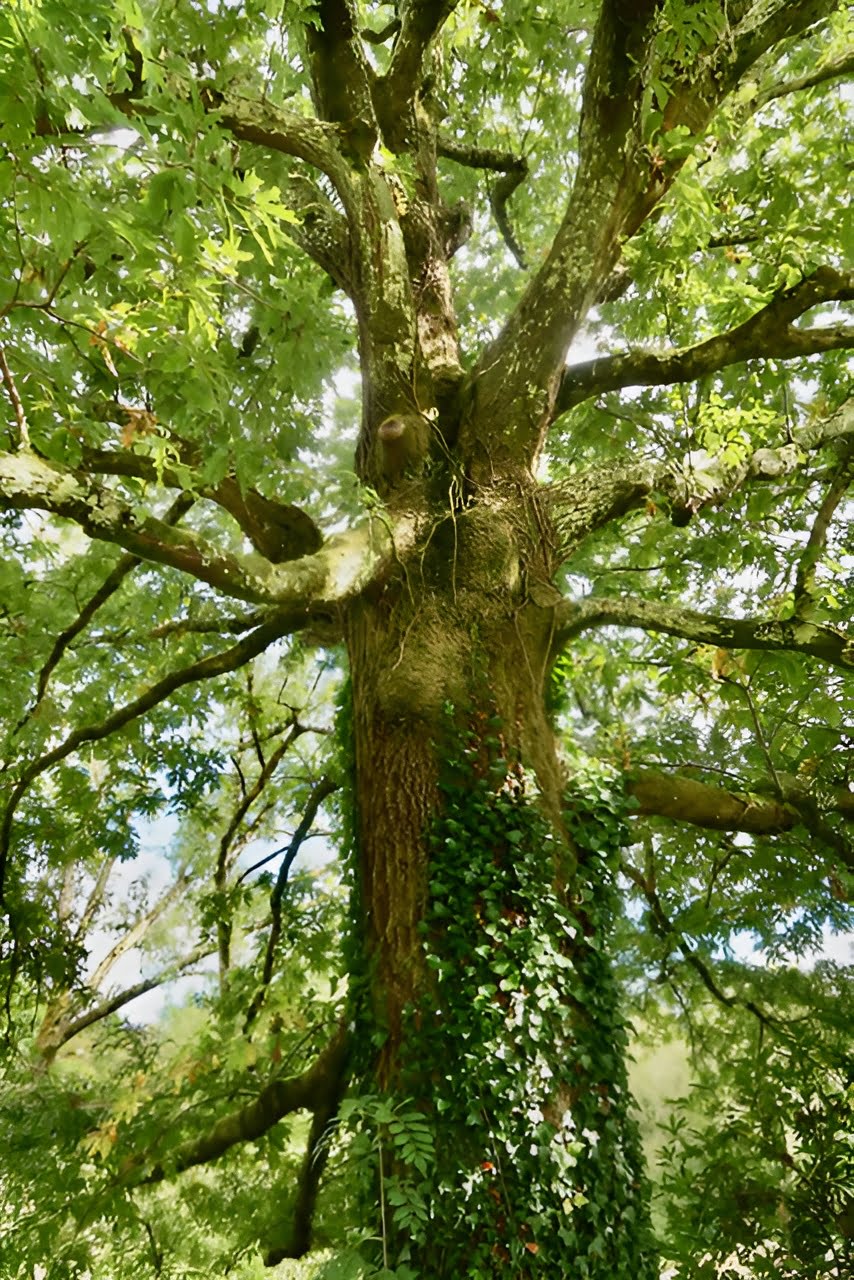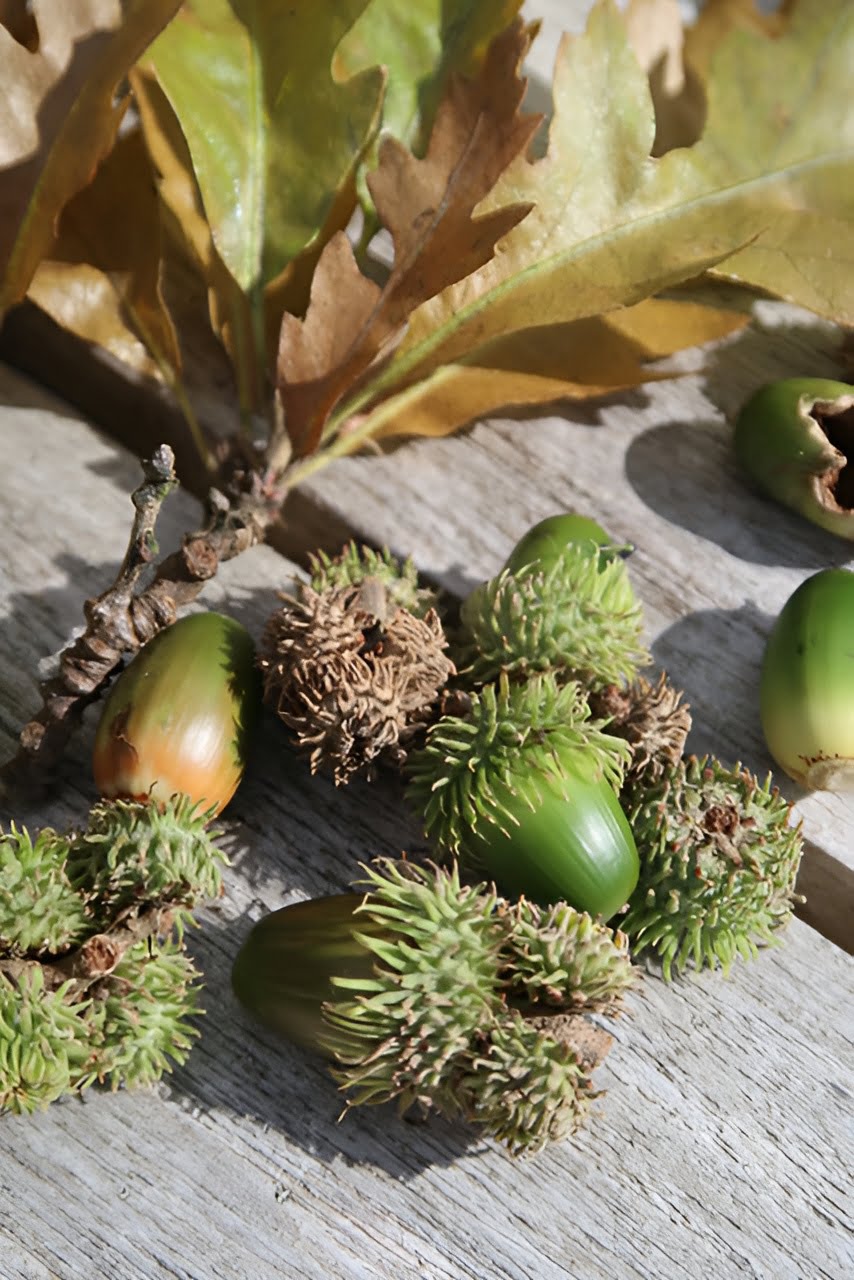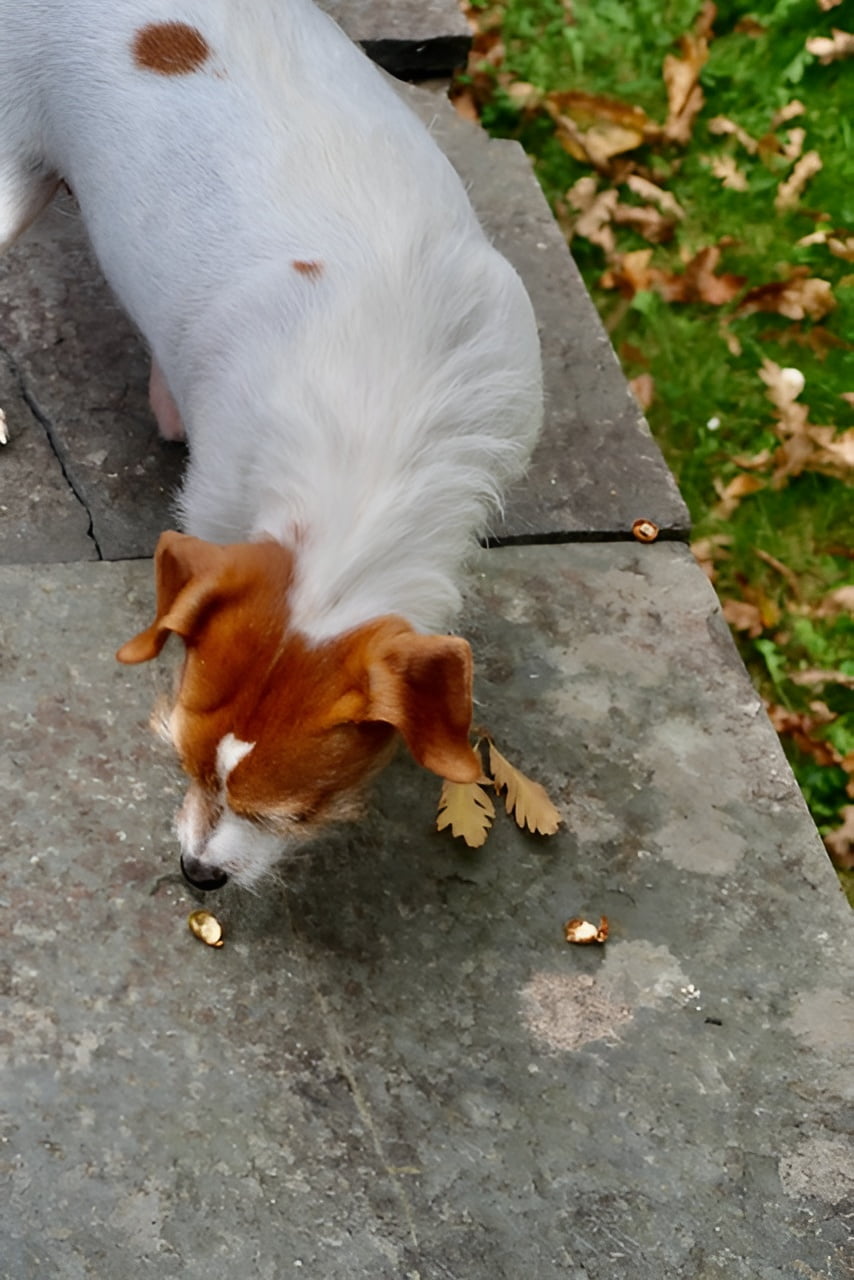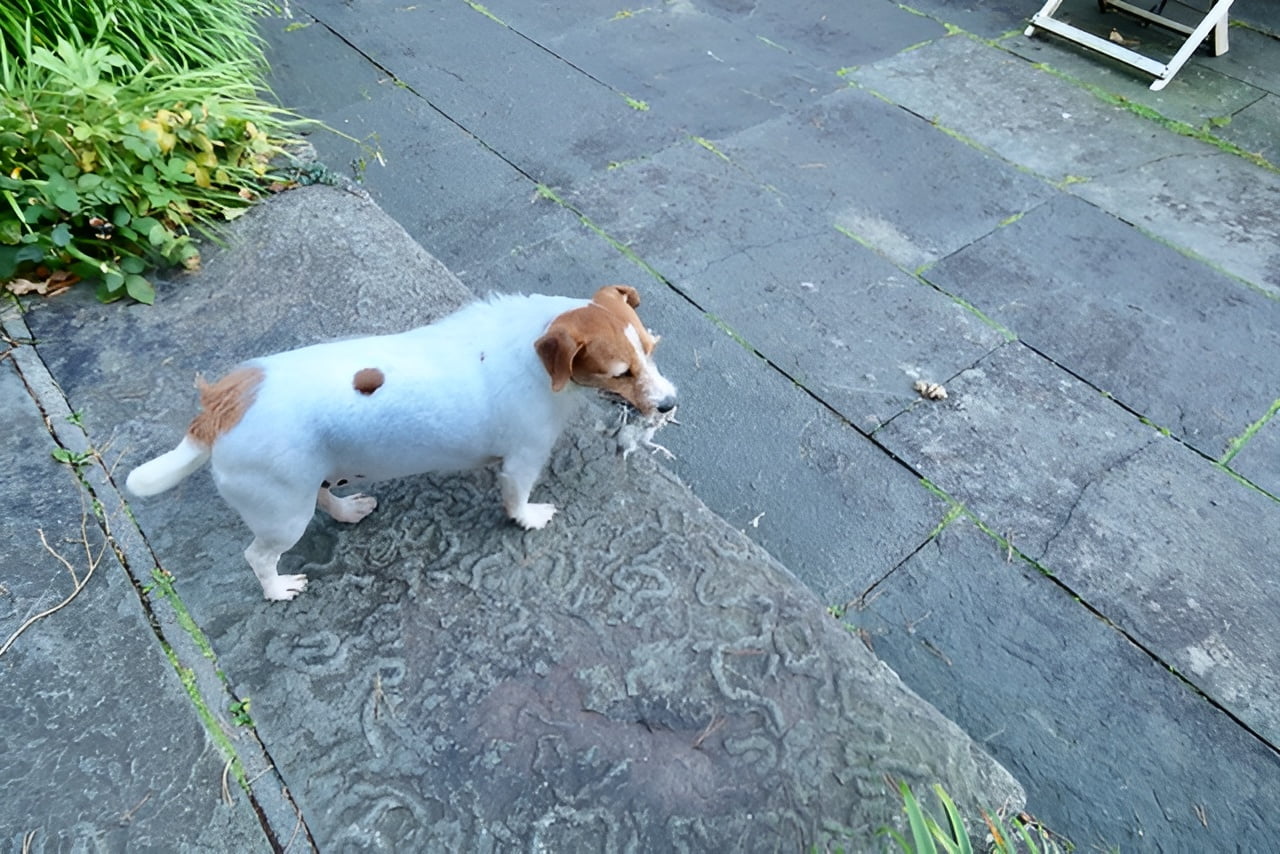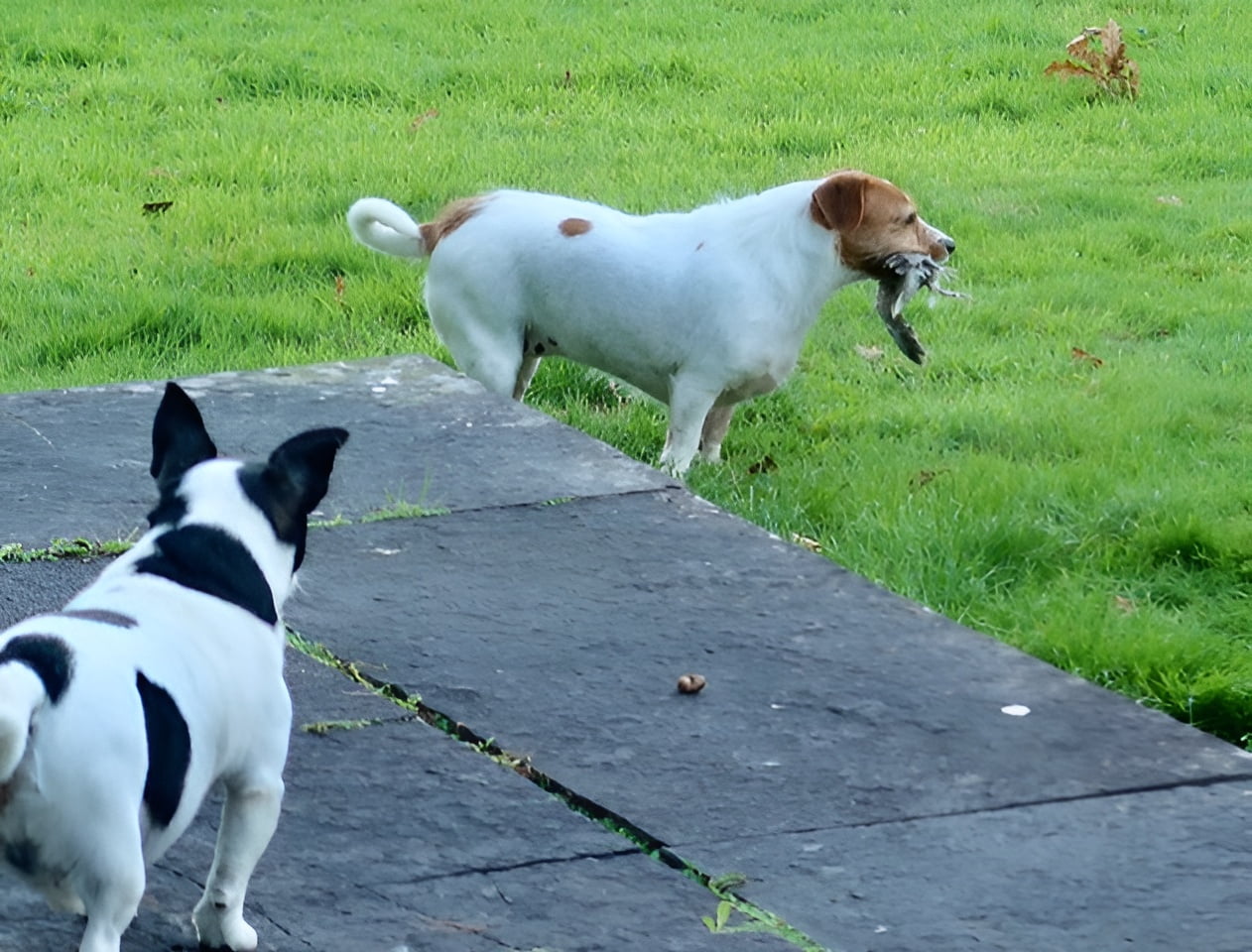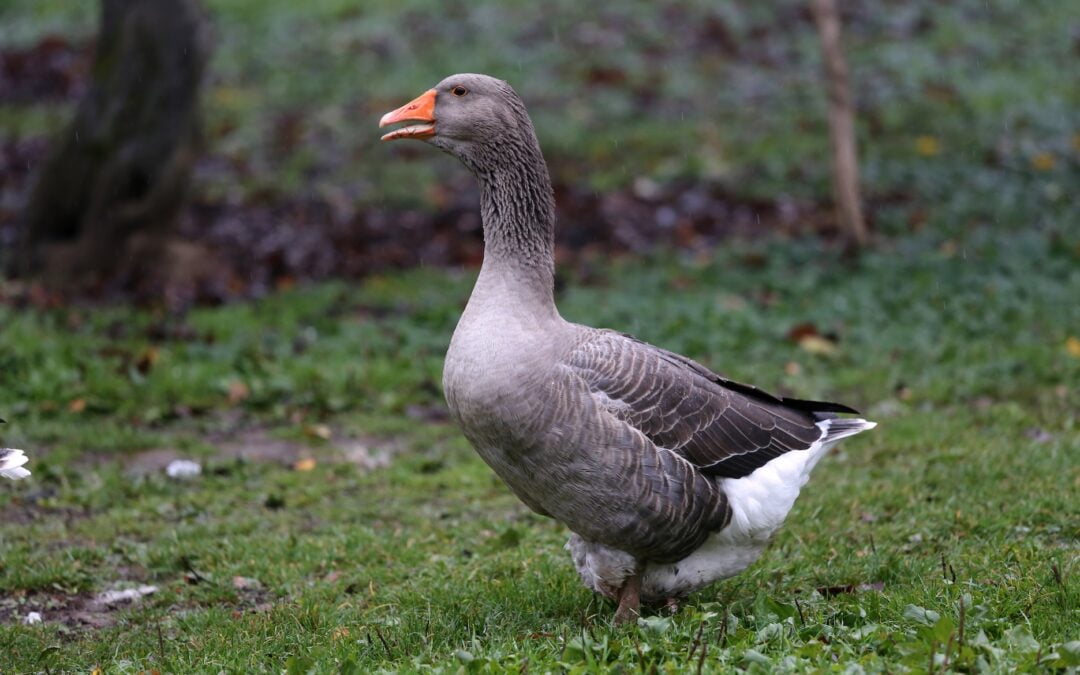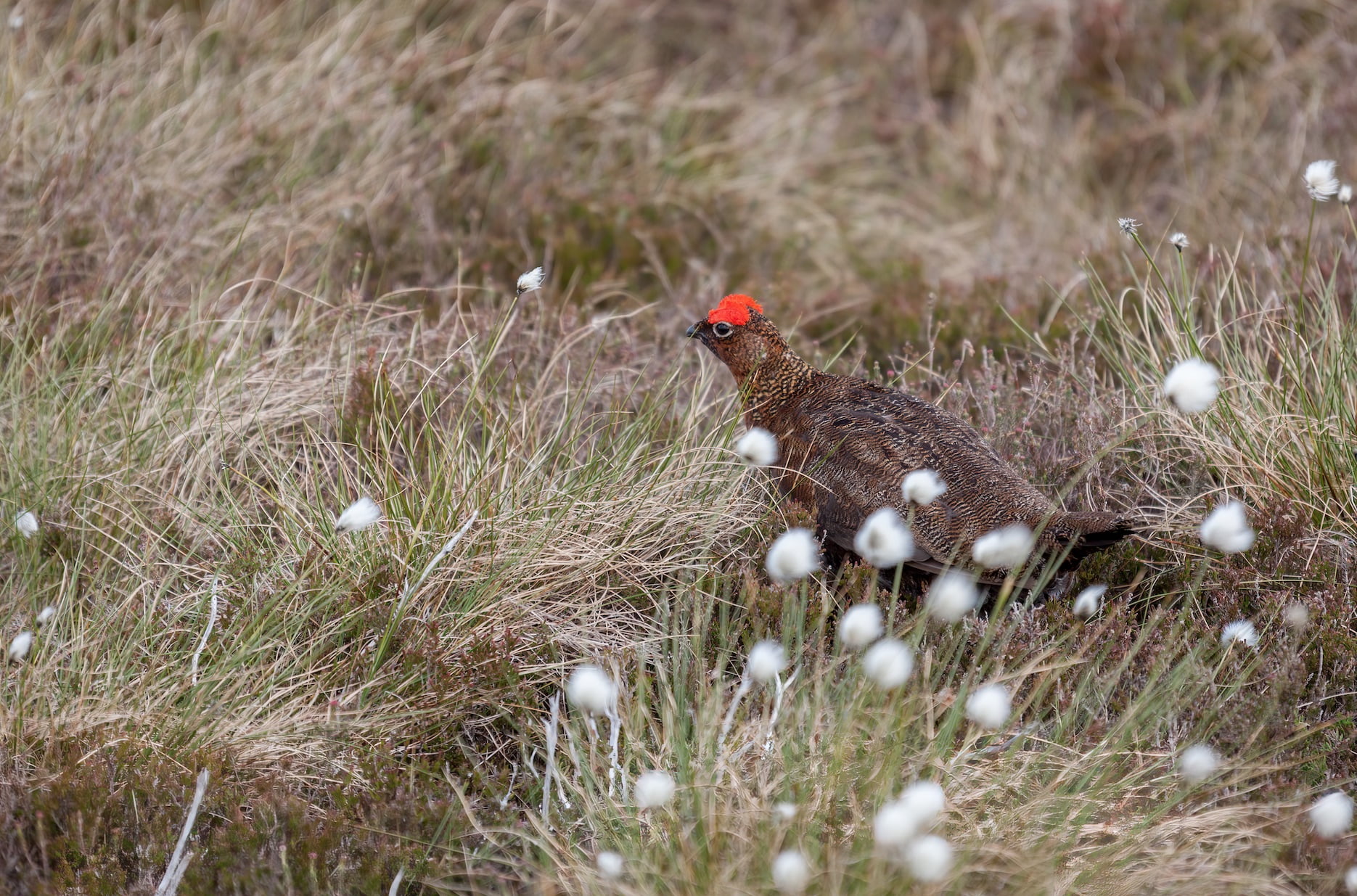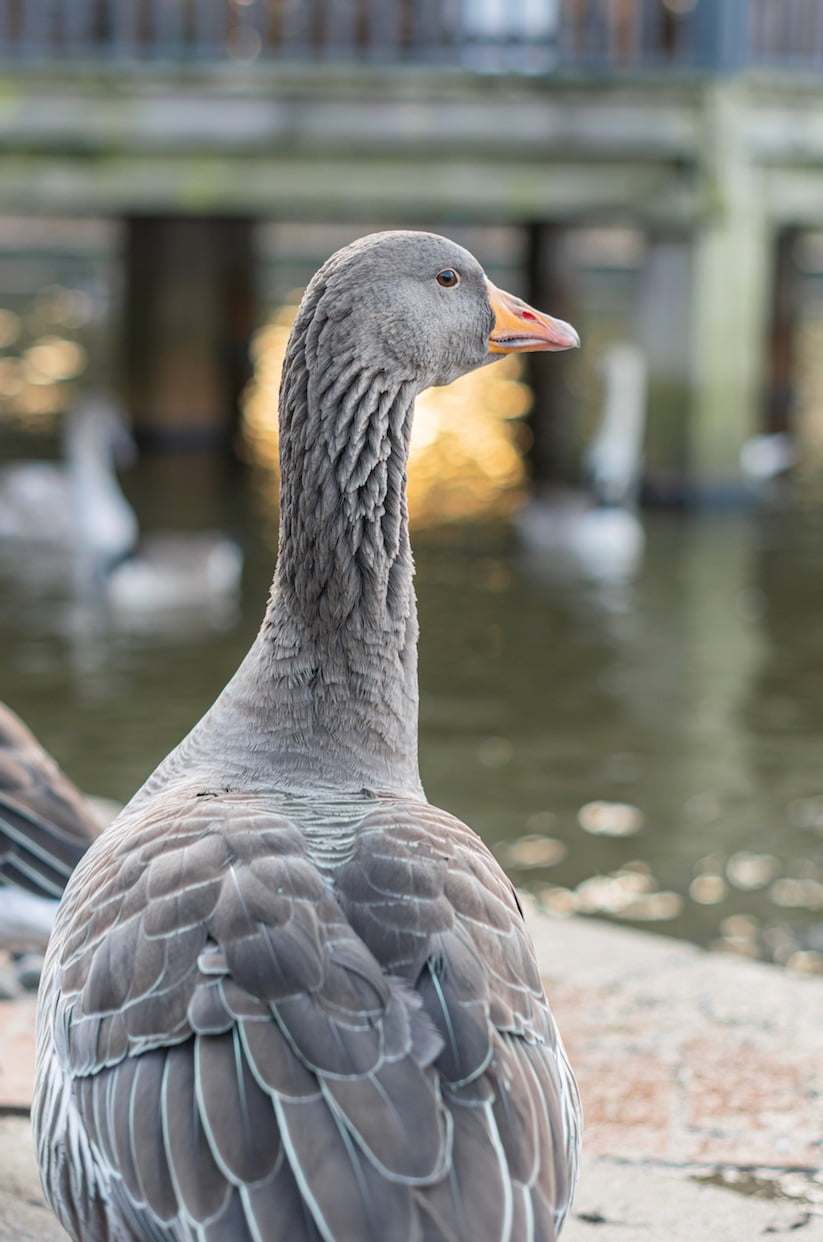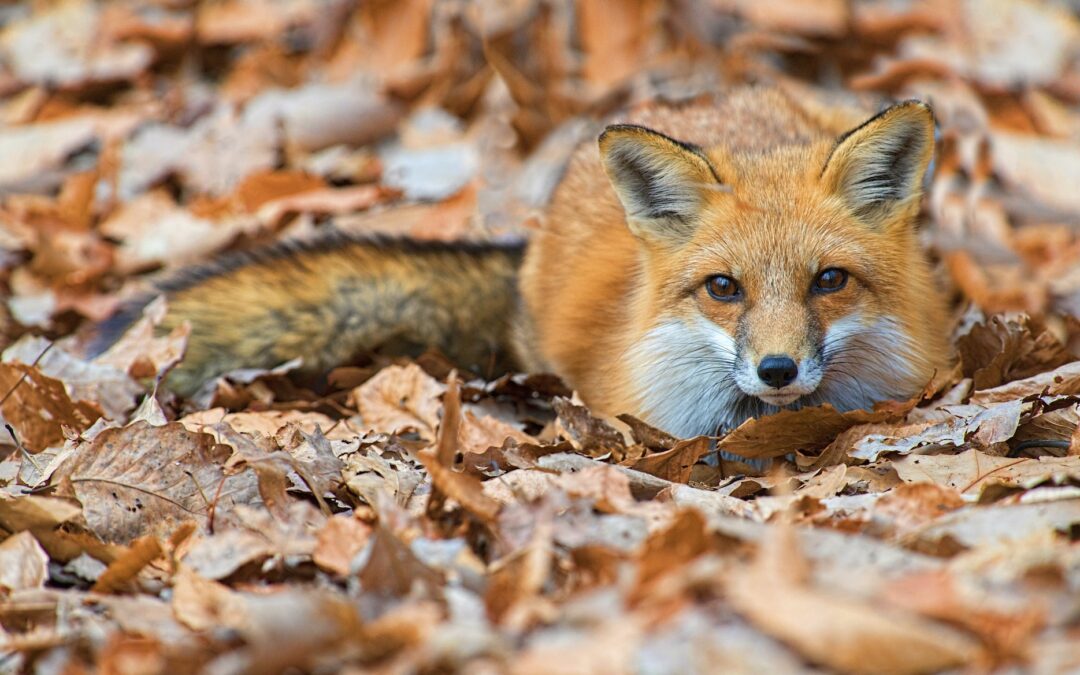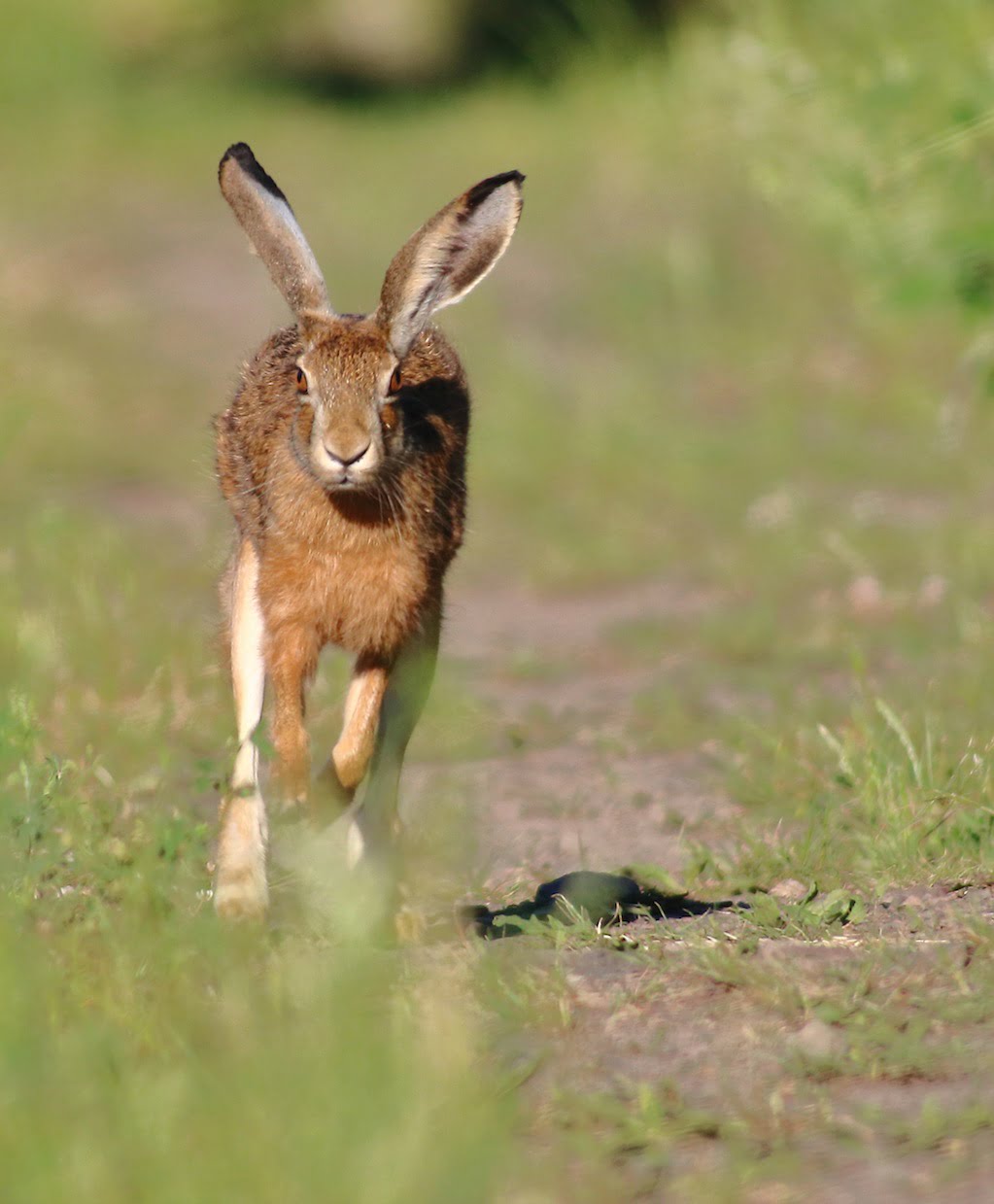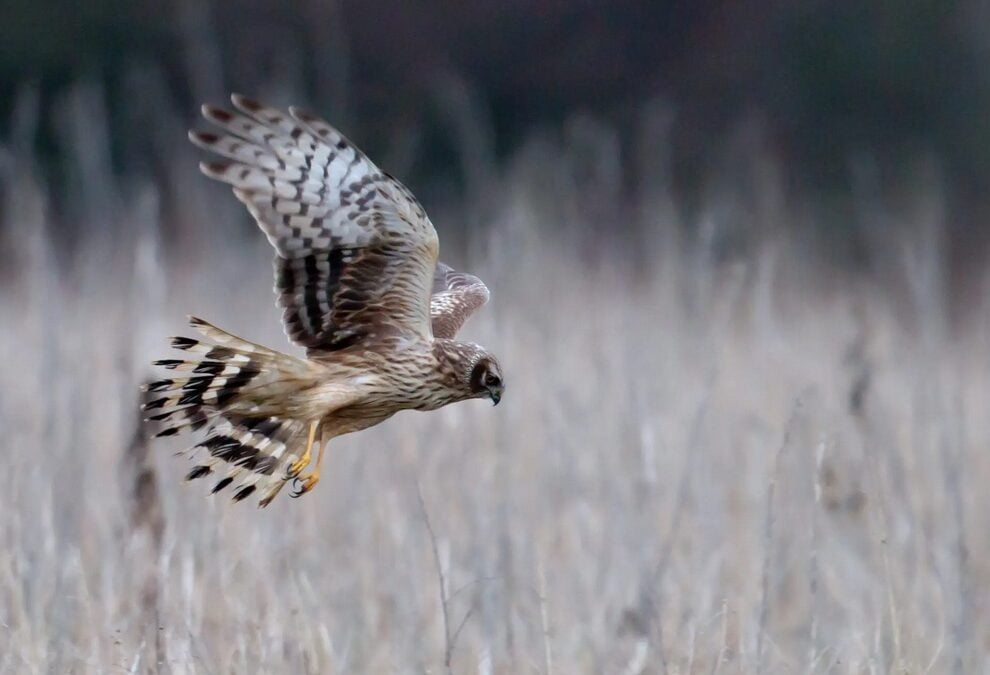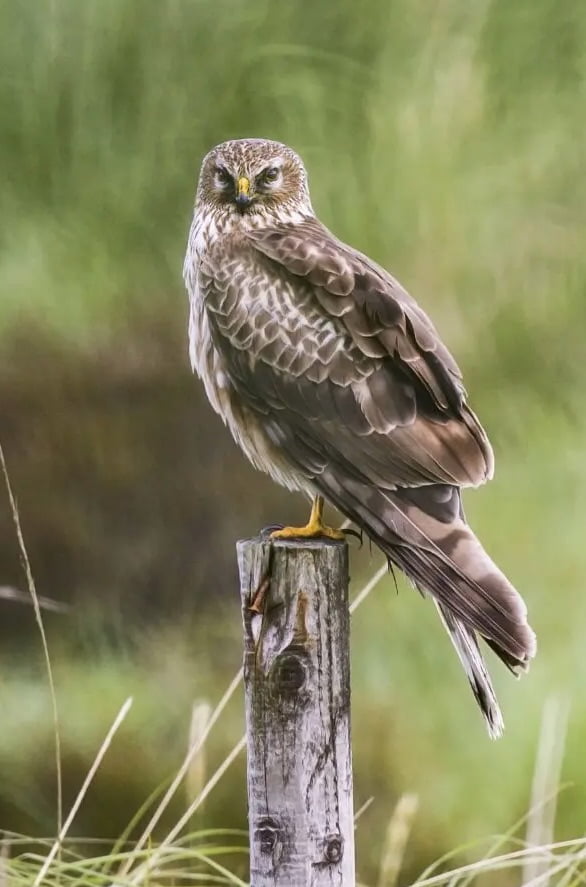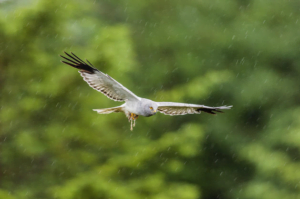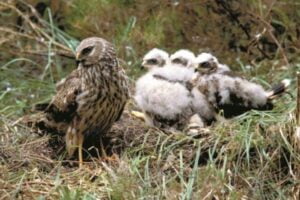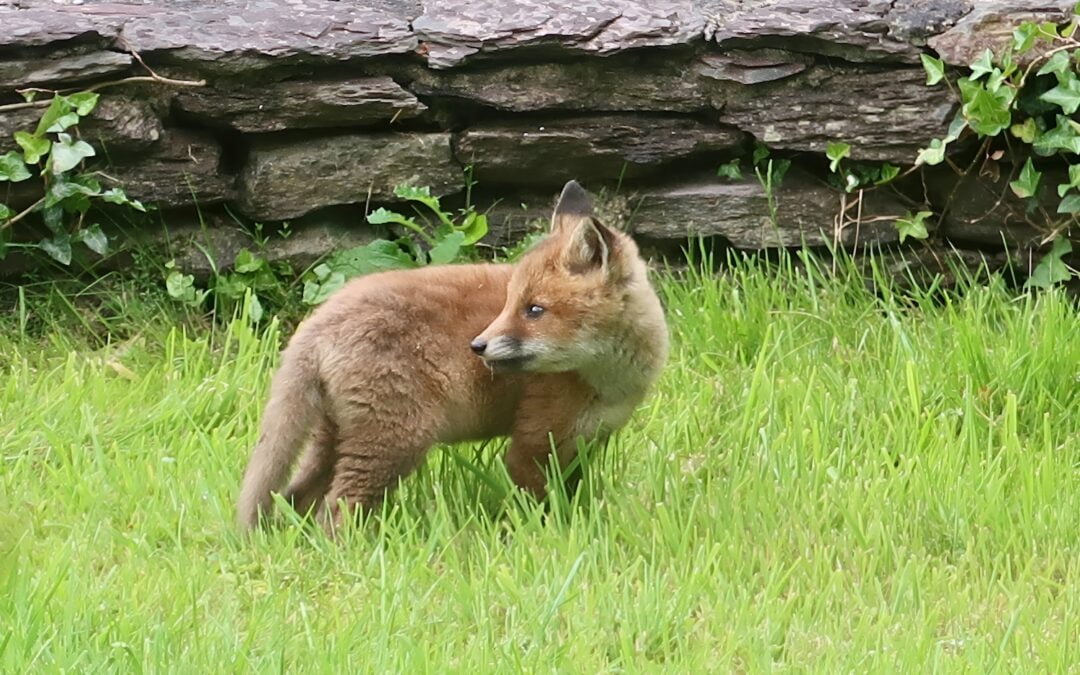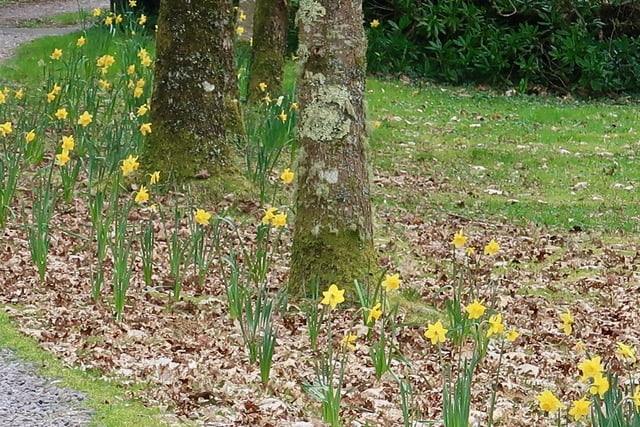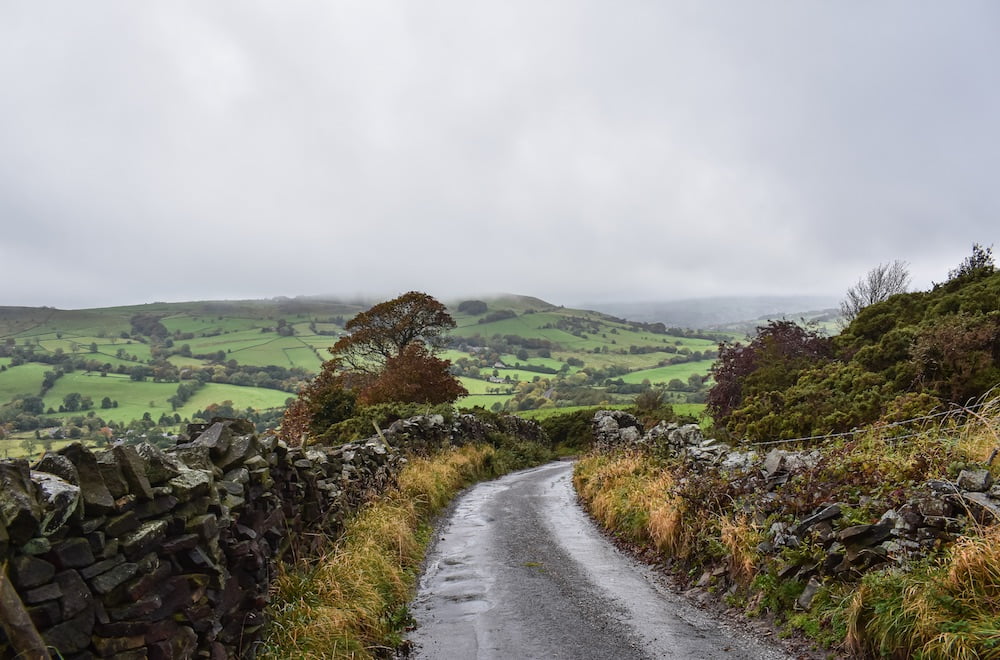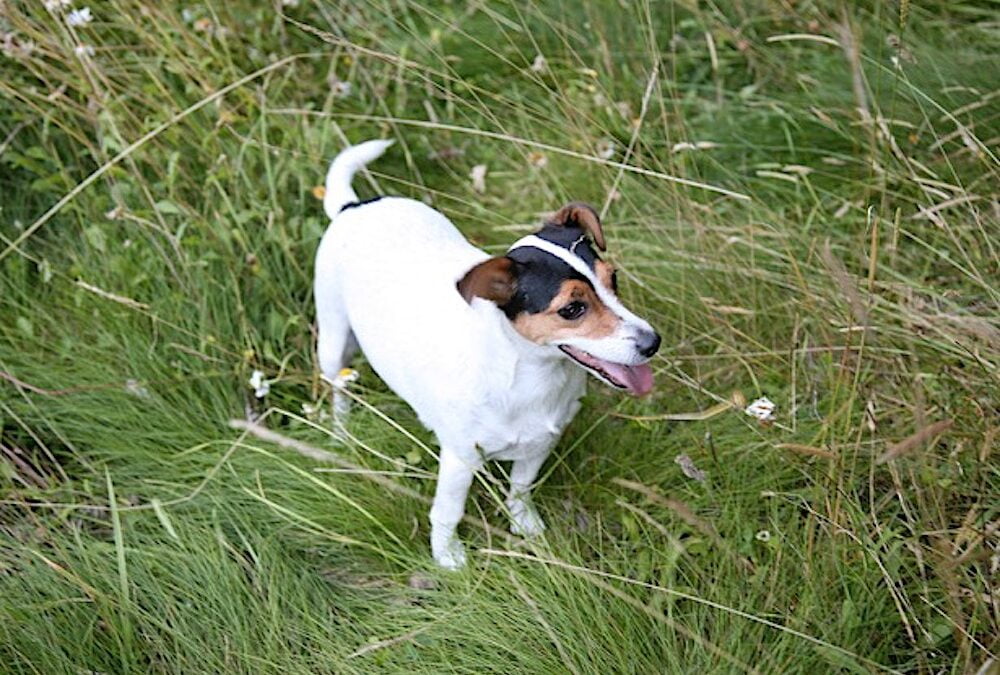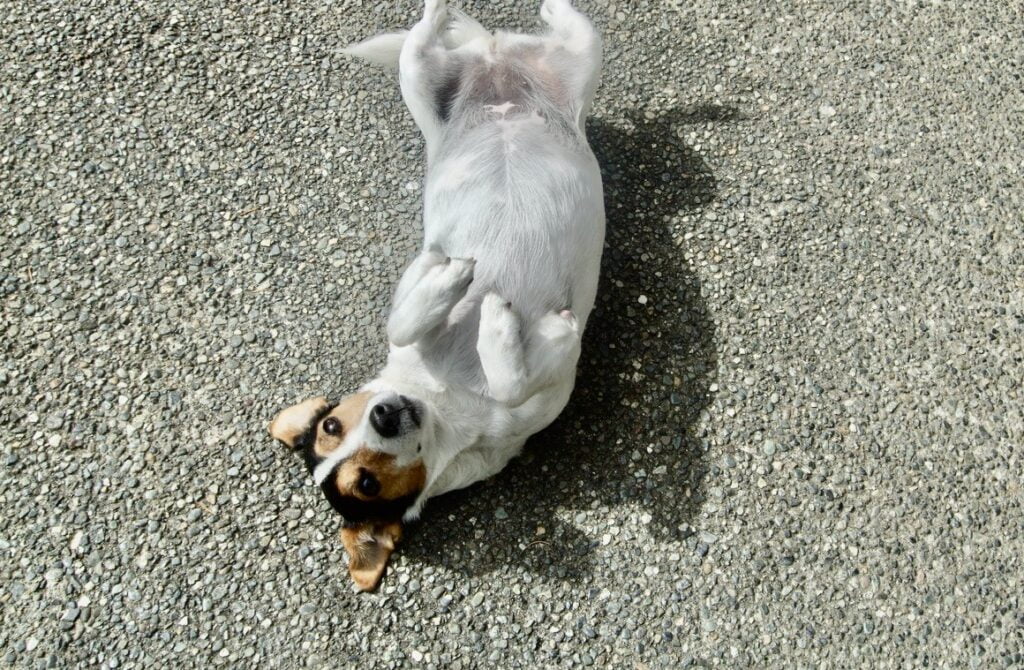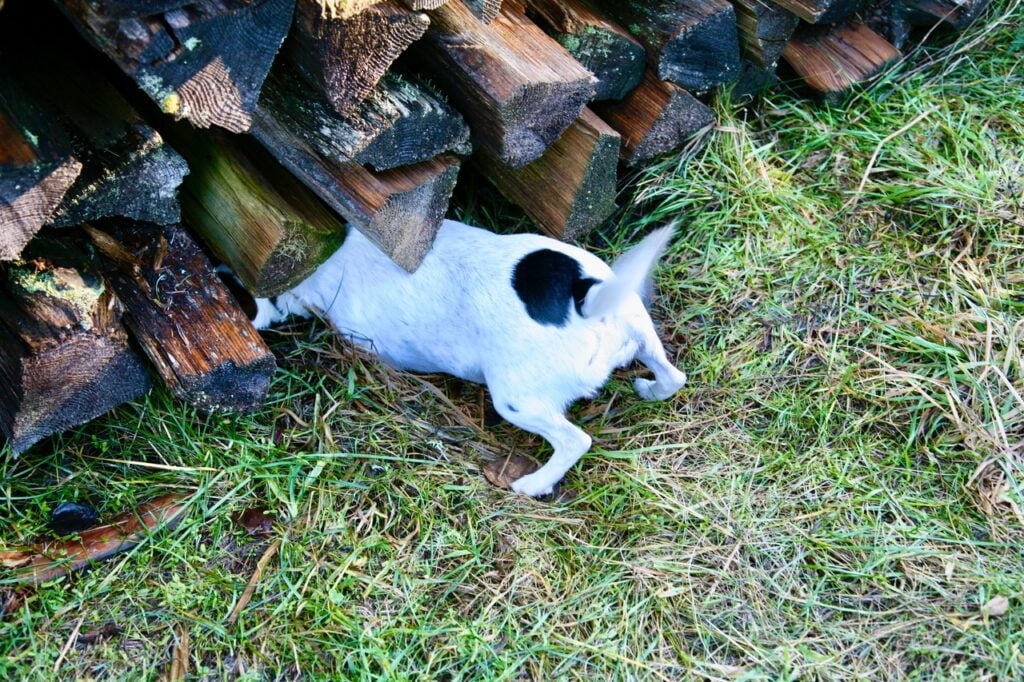
by Andrea Collins | Sep 25, 2024 | Pixie & Winston
The Autumn Equinox took place this weekend and from now on until the Winter Solstice the days and nights will be of equal length across the entire planet.
Although Autumn has only just officially arrived my two oak trees have been dropping leaves and acorns for the past few weeks, many of which were shaken out of the trees by crows. I wondered what was making so much noise as I watched branches swaying back and forth, until I discovered a large group of large hooded crows fighting over the acorns. I’d never seen that before and didn’t know crows liked acorns. (Sadly, I haven’t seen any Jays this year and they love acorns)
Pixie likes them too. For the first time since we bought her two and a half years ago my female Jack Russell started eating them.. But then she does like nuts so maybe it’s not such a stretch. And Jack Russell’s are foragers by nature.
Winston, my eight year old, male, Jack Russell, showed no interest in eating acorns – and decided to kill a rabbit instead. It must have come into the fenced dog garden, through the gate, and then got trapped behind the wire fencing when it tried to escape. I heard the squeals and was very upset when I discovered (too late) that he’d killed a very large rabbit.
I was very upset with him and told him “a tiny mouse is one thing but a big fluffy rabbit was not okay”
He seemed unapologetic, and actually seemed quite proud of himself as he paraded around the garden holding the rabbit in his mouth, head held high, showing it off like a trophy. There’s no doubt he was trying to impress Pixie who paid no attention to him at all..
After watching him bury and dig up the rotting corpse several times during the day and unable to retrieve the dead rabbit. (he was never too far away) I decided to intervene before he dragged it into the house. I watched and waited, with rake in hand, until he suddenly became distracted and dropped the rabbit. Then (much like a hunter gatherer would have done to steal the wolves’ prey) I ran towards the rabbit with my rake and quickly scooped it up. He was not happy with me at all and growled menacingly as I hurled his trophy over the hedge and into the field. Thankfully, It wasn’t too long before the crows found it. “I’m sorry Winston, but it had to go”
Later that day Pixie, who had never killed anything in her life decided to kill a young collared dove. Not to be “outdone” I suppose, she emerged from the bushes with the dead bird held firmly in her mouth. as if to say “I can do more than eat ground fall”. “Oh no”! Not again” I said to myself.
“What is going on with you guys today? I thought you were nice dogs and only chased after small mice and the odd rat for fun”
The dead dove’s head was dangling out of Pixie’s mouth and she wouldn’t let go. She wasn’t going to let Winston have it either, so I picked up the rake and walked towards her hoping she’d drop it and run away; instead she looked at me and started eating the doves head. I couldn’t believe it. I watched in horror as she chewed off its head and then began devouring the rest of its body. feathers and all.
Suddenly Winston, probably in a fit of jealousy, decided to try to make a grab for it and a major fight ensued with viscous growling and feathers flying everywhere. I charged at them with a rake hoping to break up the fight but there was nothing much left of the bird, by the time I got there – it had been ripped to shreds. I threw what was left of the poor bird over the hedge.
As this ‘blood- thirsty’ behaviour coincided with the supermoon or ‘blood moon’ and with a partial lunar eclipse, I wondered if they were acting out some kind of ancient hunting ritual embedded in their their wolf DNA? Or perhaps they had just been “moonstruck”? (mentally deranged, supposedly by the influence of the moon; crazed)
There had to be a reason behind their actions because Winston has never killed anything more than a mouse before, and I’ve never seen Pixie kill anything.
Whatever the reason I was relieved to see Pixie eating acorns again and Winston chasing after the birds on the grass.
And finally (and thankfully) I don’t have any pictures of Winston carrying his “trophy” around, but this little fella was sitting on the garden gate looking at me this morning…he even did a cute little pose for the camera, so I decided to include a picture of him instead.
Happy Autumn!

by Andrea Collins | Sep 16, 2024 | We Are The Ark
“Sustainable hunting” of endangered birds: Nature Minister’s outrageous response to protection plea.
What is going on? If Minister Noonan wanted to obliterate these endangered birds from our foreshores and lakes then he is going the right way about doing it. What is wrong with politicians, who have a duty and responsibility to protect our endangered birds, and then do the complete opposite, under the guise of allowing “sustainable hunting”? Do the recreational hunters of these amber and red listed birds have so much power that they can lobby to kill anything they want regardless of the long term consequences?

This article below appeared in Irish Council Against Blood Sports on 15 Sept 2024
[Note: Any donations made through Change.org go directly to Change.org. If you wish to donate to the Irish Council Against Blood Sports to support our campaigns, Thank you]
The office of Green Party Minister of State for Nature Malcolm Noonan has stated that he is focused on the “sustainable hunting” of birds.
The outrageous statement was in response to an appeal from the Irish Council Against Sports for the Minister to remove threatened amber- and red-list birds from the open season order which allows recreational shooters to blast them out of the sky for fun.
In our May appeal to Minister Noonan, we stated: “We are writing to renew our appeal to you – during National Biodiversity Week and ahead of the much anticipated broadcasting of the Birdsong documentary on RTE 1 – to please remove all the remaining amber- and red-list birds from the Open Season Order.”
We went on to list the RED LIST BIRDS OF HIGHEST CONSERVATION CONCERN: Snipe (breeding populations of snipe now “IN SEVERE DECLINE”), Golden Plover, Shoveler, Red Grouse, Woodcock.
and the AMBER LIST BIRDS OF MEDIUM CONSERVATION CONCERN: Mallard, Teal, Gadwall, Wigeon, Tufted Duck, Greylag Goose.
“These birds are in trouble,” we reminded the Minister. “They have been identified by Birdwatch Ireland and RSPB Northern Ireland as birds of medium conservation concern and highest conservation concern. Please act now to safeguard the future of these vulnerable species.”
We referred to his previously stated commitment to “support sustainable hunting practices”, denouncing it as “entirely inappropriate, particularly from a Green Party representative in the context of species at risk of extinction”.
“There must be zero hunting of these species and definite moves toward allowing all birds to live free from the horrors of recreational shooting,” we added.
In a 22 August reply, Minister Noonan’s private secretary wrote: “On behalf of Mr Malcolm Noonan, Minister of State for Nature, Heritage and Electoral Reform, I wish to refer to your correspondence in relation to the Open Season for Birds.
“Minister Noonan has committed to the establishment of a stakeholder forum on the sustainable hunting of wild birds. This forum, which will facilitate discussions and collaboration with relevant stakeholders on the issue of sustainable hunting, will include hunting organisations, eNGOs, Government Departments and farming organisations.”
Last year, Minister Noonan removed four out of 15 amber- and red-list birds from the shooting list. A statement from the Department of Heritage at the time outlined that the reason scaup, pochard and goldeneye were removed was “due to the great decline in their numbers in Ireland”. It revealed the shocking extent of the demise – “over the period 1994/95 to 2019/20, estimated declines of 89% (scaup), 79% (pochard) and 67% (goldeneye) have been recorded”.
Pintail was also removed from the shooting list “due to the very small numbers in Ireland at this time” (estimated to be just 1,107 individual pintails).
According to the Department, the decision to remove the birds was made “in order to ensure that the hunting of the species on the open season order is sustainable and in line with Ireland’s obligations to safeguard threatened bird species and the ‘principles of wise use’ under the EU Birds Directive”.
It is imperative that Minister Malcolm Noonan proceeds to fully protect the remaining 11 amber- and red-list birds from shooters. Join us in contacting him.

ACTION ALERT
Tell Minister Malcolm Noonan to stop the killing and give full protection to Snipe, Red Grouse, Shoveler, Golden Plover, Woodcock, Mallard, Teal, Gadwall, Wigeon, Tufted Duck and Greylag Goose and all birds.
Malcolm Noonan TD (Green Party, Carlow Kilkenny) Minister of State for Nature
Tel: (01) 618 3148 OR (01) 618 3156
Email: [email protected]; [email protected]
Facebook: https://www.facebook.com/MinisterMalcolmNoonan/
X: https://twitter.com/noonan_malcolm
Heritage Minister Darragh O’Brien (Fianna Fail, Dublin Fingal)
Tel: (01) 618 3802 OR (086) 251 9893
Email: [email protected]; [email protected]
Facebook: http://www.facebook.com/DarraghOBrienTD
X: http://twitter.com/DarraghOBrienTD
The threatened birds blasted to death by shooters
The Snipe is a threatened red-list species of highest conservation concern. Breeding populations are now “in severe decline”. Shooters are allowed to kill Snipe during 153 days of the year (1st Sept – 31st Jan).
The Red Grouse is a threatened red-list species of highest conservation concern. Shooters are allowed to kill Red Grouse during the month of September.
The Shoveler duck is a threatened red-list species of highest conservation concern. Shooters are allowed to kill Shoveler ducks during 153 days of the year (1st Sept – 31st Jan).
The Golden Plover is a threatened red-list species of highest conservation concern. Shooters are allowed to kill Golden Plovers during 153 days of the year (1st Sept – 31st Jan).
The Woodcock is a threatened red-list species of highest conservation concern. Shooters are allowed to kill woodcock during 92 days of the year (1 Nov to 31 Jan).
Teal, Gadwall, Wigeon, Tufted Duck – amber-listed birds of medium conservation concern. May be shot throughout the state between 1st September and 31st January.
The Greylag Goose – this amber-list bird may be shot between 1st September and 15th October (anywhere in the state) and also between 16th October and 31st January on Lady’s Island, Wexford and in Gearagh East and West in County Cork.
See the open season order
Read the “Birds of Conservation Concern in Ireland 4: 2020–2026” report
SEE ALSO
Birds removed from shooting list after suffering ‘great decline in numbers’
Minister Noonan: “Conservation concerns” about most birds that shooters are killing
Red-list birds blasted to death
5-year licenses for shooting threatened red-list birds
Over 4,000 licenses granted for killing on state foreshores
NPWS licences allow killing at foreshores and 43 lakes

by Andrea Collins | Aug 30, 2024 | We Are The Ark
Blood sports, where animals are pitted against one another in violent confrontation, are a cruel practice that has no place in a compassionate society. As an individual who cares deeply about our wildlife and opposes any form of animal cruelty, it’s upsetting to see these type of activities still going on in Ireland today.
It’s good to see that The National Parks and Wildlife Services are offering the public an opportunity to help them update their inadequate wildlife protection.
“The National Parks and Wildlife Service (NPWS) has opened a public consultation on review and the updating of wildlife legislation. I hope that anyone concerned with the atrocious cruelty to wildlife that shames our culture will make their views known by the closing date of September 13.
And I pray that that this process will lead to a drastic overhaul of wildlife laws because currently these fail to protect our treasured fauna.

The Irish Hare, supposedly “protected” under the Wildlife Act, can be captured, held in unnatural captivity, and then forced to run from dogs. Thousands of them are netted each year for coursing despite the fact that this native mammal (the Irish Hare is a sub-species of the Mountain Hare that is unique to Ireland) has been in decline for the past half century due to habitat loss.
The fox lacks even the “protective” fig-leaf accorded to the hare. It can be killed all year round…by lampers, mounted hunts, and snaring. This wonderful wild dog of the countryside is hounded by people whose idea of fun is ending the humble life of an animal whose nervous system is similar to that of any domestic dog.
The badger’s “protected” status, like that of the hare, counts for little, given its role as a handy scapegoat for the State’s failure to eradicate Bovine TB. Since 1984, more than 120,000 of the shy nocturnal creatures have been snared and shot.
Then there are the birds officially “protected” but still being shot for sport. These include red-listed Snipe, Golden Plover, Shoveler, Red Grouse and Woodcock and amber-listed Mallard and Graylag Goose.
These birds should be removed as a matter of urgency from the Open Seasons Order that allows gunmen to shoot them.
I hope people will avail of this opportunity to demand the end of practices that make a mockery of “wildlife protection” and that the government will then implement the will of the people.”
This letter written by John Fitzgerald first appeared in the Irish Daily Mail, August 26th 2024
For those who wish to get involved please send a submission to the NPWS [email protected] before Sept.13th 2024.
Sign the Petition Here
Find out more Here

by Andrea Collins | Jul 16, 2024 | We Are The Ark

Photo: Mike Brown
As an avid supporter of wildlife preservation, I’m happy to share Birdwatch Ireland’s campaign to bring attention to the dwindling numbers of the Hen Harrier in Ireland. Please take a look at Birdwatch Ireland’s article below that brings attention to the plight of the iconic bird of prey and please consider making a donation: ”

Photo: Mike Brown
The captivating skydance of the Hen Harrier has been woven into the fabric of our uplands for generations, awakening a sense of awe and wonder in all lucky enough to witness it. Unfortunately, the disappearance of the Hen Harrier is happening before our eyes. The results of the 2022 National Hen Harrier Survey show that time has almost run out for these iconic birds of prey in Ireland, and that the species is now faring even worse than the Curlew and the Corncrake – species often held up as prime examples of biodiversity loss in Ireland. Since the last national survey, the Hen Harrier has declined by one-third in just seven years, with only 85-106 breeding pairs believed to remain in the country. Without strong and swift intervention, the Hen Harrier faces the very real prospect of extinction in Ireland in just 25 years, its skydance and chattering call no longer gracing our uplands. However, there is hope. As the Hen Harrier is one of our best-studied birds, we know what we need to do to save it.
THIS IS WHERE YOU COME IN
We know that we need a strong and fit-for-purpose national plan to save the Hen Harrier and the other species that depend on the same habitats. To date, BirdWatch Ireland staff have invested over 230 hours in fighting for a more robust Hen Harrier Threat Response Plan that will save the species. However, this work is only just beginning. As we move to the implementation phase of the plan, we need to focus our energies on ensuring a fit-for-purpose plan that actually delivers benefits for Hen Harriers and the upland landscapes on which they depend. BirdWatch Ireland will advocate for a strong Hen Harrier Threat Response Plan and call for the most ambitious actions to save this species, as well as monitor the implementation of the plan. In parallel to this, we will advocate for and continue to undertake Hen Harrier surveying and monitoring work so that we can build on our knowledge of this species and inform targeted conservation measures. To do all of this, we need your help. That is why we are counting on you to donate to our Hen Harrier Appeal.
Donate to the BirdWatch Ireland Hen Harrier Appeal here

Photo: Richard T. Mills
IF YOU LEND US YOUR SUPPORT, WE CAN:
Advocate for a robust Hen Harrier Threat Response Plan which delivers for Hen Harrier Conservation and review its implementation on an ongoing basis to ensure it is delivering for Hen Harrier populations. Purchase specialised monitoring equipment to allow us to expand our surveying and monitoring work to understudied areas outside of the SPA network, where over half of the breeding Hen Harrier population nests. Advocate for appropriate measures to retain winter stubbles and important foraging habitats for Hen Harriers. Develop efficient and accurate Hen Harrier survey and monitoring methods to allow nest location and monitoring in a non-invasive way. Review afforestation policies and advocate for improved afforestation and forest management planning to reduce the negative effects to Hen Harriers associated with habitat loss and disturbances. Create and deliver informative Hen Harrier communications materials for the public which serve to inform and inspire action. We are extremely grateful for any support you can give us, and we look forward to providing full updates on what we have achieved using your donation on a regular basis. Yours Sincerely, The BirdWatch Ireland team.”
*All images in this article are copyright of Birdwatch Ireland.
Feature Image: Shay Connolly
Photographs: Mike Brown, Shay Connolly, John Lusby and Richard T. Mills

by Andrea Collins | Jun 21, 2024 | We Are The Ark
After a wave of attacks on my ARK I’ve been reluctant to post any new updates for a while now and at one point I was tempted to move away.
Foxes have been poisoned and shot – birds, especially magpies, have been taken in Larrsen Traps and left to die, and the handful of deer I’ve come to know over the years have also been shot.
Unfortunately I am surrounded by farmers who do not like wildlife. They also believe that conservation groups, or anyone interested in protecting the natural world are the “the enemy”.
To make matters worse the local gardai are not interested in prosecuting farmers for wildlife crimes because it can result in a hefty fine or even a prison sentence. They would also have to deal with the outrage from other farmers who sneer at our wildlife crime laws and made sure they were sufficiently watered down not long after being introduced in 2012. They’ve been getting away with murder for so long now they believe they have the right to do whatever they want. And those outraged farmers also carry firearms whereas our gardai do not.
My own experience of finding banned “poison” laid down in a nearby field and then handing a sample over to the Gardai resulted in the gardai taking the sample from me and then somehow losing it instead of sending it to the lab. The NPWS (National Parks and Wildlife Services) wanted to prosecute (my neighbour in this case) but without the hard evidence there was nothing they could do, and my photos didn’t provide enough evidence to prosecute. One of the gardai even went as far to say “anyone could have put that in his field”. But my neighbour did receive a visit from the NPWS a few weeks later and they removed the poison he had stashed in his barn. The two local vets I contacted wouldn’t test for poison either because they both work for local farmers, so it’s not surprising that so few convictions are ever brought forward.
In hindsight Kerry wasn’t perhaps the best place to build an ARK – or maybe it was. Maybe the farmers here, with their outdated beliefs and tight control over our wild places (and wildlife) need to be challenged and held to account.
Shooting at foxes would make some sense if my local farmers were raising sheep or hens but they are raising cows and have no justification for killing anything; they do it simply because they don’t like wildlife and they know they won’t get charged. They believe only domesticated animals have the right to graze in their fields and recently lobbied to increase the deer hunting season, which means they can now legally shoot pregnant females. The explanation we were given by government sources was “we have too many deer in Ireland” but those who voted against the extension tell me “the farmers just don’t want deer on their lush spring grass”.

In better news the new CAP (Common Agricultural Policy) laws have been changed to allow farmers to re-wild up to 30% of their land. I’m optimistic it’s a step in the right direction, and with a new generation of young farmers taking over the old guard, there’s a good chance we’ll see them putting more land aside for nature, as time goes on. We need young blood to embrace the new guidelines because a huge 70% of the land in Ireland is currently used for agricultural purposes, meaning there are v fewer places left for our wildlife to exist.
ARK founder Mary Reynolds feels that Ireland has almost forgotten about it’s wild places:
“Ideas of control are hard to relinquish. Ireland has a history of locking up wildness and throwing away the key. Weedy unkempt places have associations of poverty. Letting the land go was a visible sign of defeat or grief for many people, the loss of loved ones through bereavement or emigration. Prosperity has been drawn on the landscape with ripped-out hedgerows and a blank green carpet of heavily-fertilised rye grass. We need a new story about wild places”
There is also good news from our NPWS who have recently added a Wildlife Crime page to their website making it easier to report wildlife crime and prosecute offenders. A few months ago when I was reporting my own ARK attacks no such page existed. It took a lot of emails and phone calls before I could find anyone to help me. So this is heartening news.
Useful links:

by Andrea Collins | Mar 21, 2024 | We Are The Ark
Today is March 21st – officially the first day of Spring! This is a time to celebrate new beginnings and look forward to the year ahead.
Spring flowers and buds have begun growing again after their long winter sleep. They are unfolding and bursting into life everywhere, signalling a time of renewal, hope and rebirth.
The dawn chorus has reached fever pitch and birds are singing throughout the day now hoping to attract a new mate. They are literally “full of the joys of spring”. This is my favourite time of year – a time when we are finally liberated from the dark, short winter days and able to spend more time of outside in Nature. The dogs are happy too, as they begin to savour more daylight hours and the extra walks!
Last year three of us planted over a hundred Irish daffodils on the grassy areas either side of the treed driveway, and It was the first year I didn’t rake up the leaves. To my surprise they are still pretty much in place, although a few have migrated across the grass. I’ve watched them slowly mulch down and also provide grubs for the birds to feast on during the long winter months.

The daffodils began to appear in early February – their bright green shoots pushing their way through the brown leaves and yellow buds waiting to unfurl. I didn’t know how many of the bulbs we planted would survive the winter, but they all seem to have flowered apart from a few who had their heads eaten off by passing deer.
Now the daffodils are fully open and the whole area looks more like a woodland garden than the patches of fertilised lawn, I inherited when I moved here four and a half years ago. And moss is slowly replacing much of the grass, creating different hues and textures while returning the land to its natural state. It looks as though it has always been here – growing under the trees and covering their large root systems. The daffodils and moss (and dead leaves) have transformed what was a dead grassy area into a vibrant, living eco-system.
Mosses play an important role in our eco-systems because they offer ‘microhabitats’ that are critical to the survival of organisms and provide shelter for insects to live. They also help retain moisture, which is good for the daffodils, and birds like to dig under the moss looking for grubs and insects to eat.
The brown, dead-looking hedgerows are also returning to life, filling up with violets, primroses, daisies, dandelions and broom – while many of the different species of shrubs and trees growing there are covered with tiny leaves and buds. We have finally begun to transition away from the stagnant days of winter and into a new season of renewal and rebirth.

I recently learned that buds can be used to make tinctures. The methodology is called Gemmotherapy—derived from the Latin words “gemmae” (buds) and “therapeia” (therapy) and these tinctures can act as a natural immune booster containing anti-fungal, antimicrobial, anti-inflammatory, and antioxidant agents. Once harvested the buds can be soaked in glycerin and alcohol for three weeks before the tincture is ready to be used. There are several websites that provide instructions on how to do this including the links page for this blog, and they provide a long list of suitable trees buds which can be used to make tinctures. Oak tree buds are on that list and are said to make a good general tonic. I’d like to try making some of that myself as my two large oak trees are on the verge of forming buds.

My apple and plum trees are now covered with blossom and I’m hoping that my new resident bees will take care of any pollination problems I encountered last year when none of my trees bore fruit. When the bees arrived late last summer (like the cavalry at the eleventh hour) they flew into an opening above the large bay window at the side of the house, and set up their new hive there. They cleverly arrived before the autumn weather set in and were able to collect enough pollen to make honey to keep them going over the winter months (I hoped) and I was relieved when I saw them finally emerge from their hive a few weeks ago, and begin to fly around outside, checking out their new surroundings, and looking for pollen. I’m hoping that on their travels they stumble upon my fruit trees. It would be lovely to eat some home grown apples and plums this year. and the bees will get the benefit of the yummy honey.
See the links page for more information.

by Andrea Collins | Feb 23, 2024 | Electro Sensitivity
Kerry County Council in all their wisdom have approved an application from Three Ireland to build a 30 meter (100ft) high latticed mast about a kilometre away from where I live – right in the middle of a scenic area, part of which includes the Kerry Way, a world class walking destination. The application stated that the tower would be visible for two miles in every direction and up to four miles to a slightly lesser degree. Therefore, it will dominate the unspoilt landscape consisting of green fields, streams, rivers, areas of mature native woodland, farmland, hedgerows and ancient stone walls. It will also traverse the Kerry Way, a world famous hiking trail so that walkers will literally have to walk past a massive tower along the trail. What were they thinking?
A small group of us have since appealed their decision which is now in the hands of An Bord Pleanala and we can expect a final decision from them on June16 /2024. We can only hope that they find the location of the proposed mast unsuitable and take issue with the fact that no Environmental Impact Assessment (EIA) was done.
The applicants provided council with a selection of dreary photos showing sections of the main road into Kenmare (the N 70) which included areas of hedgerows and trees, and claiming that these patchy areas of vegetation along the main road would obscure the mast from view. Well, even if the land behind the road was flat, the mast would still be highly visible from the road – but as the land rises steeply from the road up to a forested section where the proposed mast is to be located, it will literally tower over, not only the road, but the entire surrounding landscape for miles around.
Shamefully, none of the applicant’s photos showed the natural beauty of the area. The photos were very dark and the green areas looked almost black in some photos. And as the planners are not local (Tralee, north Kerry) they might not be familiar with this area at the southern tip of Kerry. The bad photos no doubt helped the planners make their decision.
The applicants also spent a lot of time talking about the “importance of digital connectivity”. It seemed more important to them than the land they were about to wreck (no surprise there). And forget about health concerns – they really don’t care how their phone masts affect people’s health. All they care about is getting their mast built. We can only hope that An Bord Pleanála takes a more conservative and conservation-minded approach when looking at all the “evidence” and over-turn Kerry County Council’s decision.

by Andrea Collins | Jan 25, 2024 | Lily
In January 2001 I started looking for a female Jack Russell puppy. Back then Jack Russell terriers weren’t registered with the Kennel Club and therefore couldn’t be sold as pedigree dogs. Instead, they were bred in rural communities to kill mice and rats – and unlike pedigree dogs, who are bred from a small gene pool, retain their character, instincts and hunting skills. They are also good at foraging for food just as their ancient wolf ancestors would have done thousands of years ago. And as the breed hadn’t been standardised the dogs came in all different shapes and sizes. Once I’d decided what I wanted it was just a matter of finding her.
Being January there weren’t a lot of puppies for sale on Salt Spring Island – and frustratingly, no Jack Russells. I was told to wait until spring, but even though it was January I had this strong feeling she would be coming into my life soon; that she was out there, somewhere, manifesting in the ether. I just needed to find her. One Saturday morning in May I planned to go into town and watch the annual Salt Spring Sea Festival. It began with a parade lead by a group of Jack Russells and their owners followed by a lot of organised activities that lasted all day. My plan was get there early enough to talk to some of the Jack Russell owners and ask about puppies, but I slept in that day and by the time I drove into town the parade was over and people were migrating into the local cafes, shops, restaurants, and nearby park where local bands were playing. I grabbed a cup of take-away coffee and walked over to the park. It was such a beautiful sunny day and the atmosphere was laid back and friendly. Lisa, a friend of mine called me over and we chatted for a while before she asked me if I’d seen that man pushing a litter of Jack Russell puppies in a wheelbarrow? She said they were leading the parade. Trying not to choke on my coffee I asked her if she knew who it was, and she said she thought it was John, the lawyer.
It turned out she was talking about John Davies, someone I knew quite well from the Texada logging days, when we were fighting to save 6000 hectares of land from the chainsaws. Lisa and I did a quick walk around town looking for John and his wheelbarrow, but couldn’t find him. At that point I decided to go home and call him.
I probably drove home faster than I should have and worried John had already all sold all the puppies, including Lily – the name I had chosen for her.
As soon as I got through the front door I ran to the phone and called John’s number and he answered right away. It was so good to hear his voice. I asked him about the puppies and he told me they were all still for sale. With a sigh of relief I then asked him if he had any females and he said “Just one”. I felt a strange tingling sensation.
We agreed that I would go to his house the following morning. I walked into his house and found a litter of tiny pups sleeping on a big, soft blanket- all except one. This lone, independent puppy was standing up – nose to the ground, tail up in the air, sniffing around very intently. If he or she wanted to get my attention, it worked. I walked over to see if it was girl or a boy and then I picked her up and said “I’m so glad I’ve finally found you!”
I noticed how comfortable she felt in my arms – as if she had always been there. I expected to take her home with me, as she was eight weeks old, but John explained that his family were ‘hand rearing them’ (socializing them) and wanted to wait until they were three months old and properly weaned. My heart sunk at the thought of leaving her behind.
Two weeks later I called John and he agreed to let me come and collect her.
I carried Lily outside and placed her in the dog bed at the rear of my car and then drove away. She didn’t whine or scratch to get out – she didn’t look worried at all – she seemed perfectly happy to be with me.
When we reached the edge of town I realised I needed to pick up some groceries and pulled into the supermarket car park.
I knew Lily wouldn’t be allowed inside and I didn’t want to leave her in the car alone so I decided to take her in with me. I sat her in the front of the trolley and put a small white towel over her head. She didn’t move – she just sat there and played along with me. I couldn’t help smiling at this little ‘ham’ as I pushed her through the sliding doors and around the aisles. We were perfect ‘partners in crime’.
On the drive back home I realised that without Lisa I might never have found Lily. But then I remembered what my friend Doreen used to say to me : “What’s for you, won’t go by you” and she was right.

by Andrea Collins | Jan 17, 2024 | Lily
There’s no doubt in my mind that Lily was an ‘enlightened’ dog – And I’d even go as far as to say that sometimes she was smarter than me. It was no surprise then that she also became my teacher.
During the fifteen years we spent together she helped me make some adjustments to my way of thinking which in the end made me a ‘better me’ – a better version of my previous self.
Not that I was messed up or strung out on drugs, but I probably needed a helping hand at that time in my life – and I now believe that’s why she came into my life.
My first lesson arrived while Lily was still quite young, and I can only assume she decided to use her stubborn technique to put my self-awareness to the test.
Noticing it was getting late and dark outside, I called Lily in from the garden one evening, I could see her sitting on the grass but she didn’t respond when I called her in. I called her several times but she didn’t respond. I tried raising my voice to a more assertive tone but that didn’t work either. She could clearly see me and hear me, so I why was she refusing to come in.
I began to feel frustrated and angry – I was supposed to be the ‘alpha’. – the leader of the pack and she wasn’t listening to me.
Feeling frustrated I decided at that moment I was either going to keep getting angry and possibly kill her (not that I’d do such a thing) or I was I going to find another way to communicate with her.
Suddenly it occurred to me that I could try a different approach; I could look at her ‘through the eyes of love’ instead of anger/blame etc (an aha! moment) I stepped outside and slowly walked towards her. I bent down and stroked her soft, smooth little head and felt nothing but love for her.
We sat together for a while and then I asked her to come inside. She followed me in and seemed happy. She knew she had taught me something about myself – that we don’t always have to be right or be in control of situations – we can stop things escalating by backing down and choosing to see love instead.
A lesson in “A Course In Miracles” states that “I can choose to see things differently”. It is a simple and yet profound lesson, which I understood for the first time that night. Usually I would not give in or back down with a dog but this time I did.
Now I sometimes wonder if the reasons Lily used to lie on her back and look up at me was to remind me that we can always choose to see things differently. We don’t have to be right or always in control. We can choose to believe if the other person (or in this case dog) is the problem or not. It’s not what happens, it’s how we respond to it. That was a great lesson for me. This also ties in to ‘forgiveness, but more about that another time….

A few days after my first revelation I bought Lily some coloured balls and began rolling them towards her as she sat outside on the grass. She stared at them as they rolled by, and looked unimpressed. I was surprised because i knew Jack Russells were playful and loved their toys, so I carried on gently throwing the balls towards here hoping she’d take the bait, but she didn’t. She just sat there looking bored. Finally, she stood up in an effort to make her point. She grabbed one of the balls in her mouth, held it there for about ten seconds and looked towards me. After making sure I had seen the ball in her mouth, she opened her mouth and let the ball drop to the ground.
Lily was demonstrating to me as clearly as she could that she knew how to catch and run with balls she just didn’t want to do it.
It turned out she preferred chasing and catching mice instead.
I’d watch her outside in the long grass, as she would pounce on the mouse, grab it and then shake it to death. She’d then take the mouse in her mouth and gently but firmly break its neck just to make sure it was really dead. In her mind it was the humane thing to do. Better to finish them off than leave them wriggling around on the ground.
One cold winter afternoon Lily and I walked into the barn to get some horse feed and hay bales to feed the horses. I opened one of the barrels of grain and saw six mice running around inside. I tipped the barrel sideways, just far enough that the mice could escape and run out onto floor.
Lily wasted no time picking them off.. She chased and caught every single mouse in turn and then flung them against the side of the barn to kill them. They sounded like rocks when they hit the wall and fell to the ground, dead.
I have no idea how she came up with the idea of flinging’ them instead of shaking them in her usual manner but perhaps she needed to find the quickest way to deal with six mice in the quickest time possible. (they were gone in about thirty seconds) She had this amazing ability to think on her feet and adjust to any situation.
Lily’s methods of rodent extermination might seem cruel to some, but it was quicker and much kinder than laying out mousetraps or poison bait. Poisoned rodents die a slow, painful death and then their poisoned bodies kill the hawks and owls that feed on them. On the other hand a good “mouser” can kill rodents quickly and efficiently, without harming any other creatures.
And Lily was one of the best.
Here she is looking for mice under the log pile.


by Andrea Collins | Jan 4, 2024 | Electro Sensitivity
Ever noticed how phone masts seem to dominate the landscape no matter where you are? A residential area, retail area, area of natural beauty, phone masts dominate the landscape just so we can stay connected on our mobile phones. Apart from being a “blight” on the landscape, having the convenience of a mobile phone 24/7 has resulted in some of us getting sick.
Up until 2011 my addiction to using a mobile led to a complete breakdown of my body’s ability to mitigate the constant barrage of wireless microwave radiation. My phone was literally making me feel ill – so I put it away in a drawer and began the ‘learning curve’ of learning to live without it.
My reaction to microwave radiation meant I was now called “electro-sensitive” but no-one in the mainstream media seemed to want to talk about us unless we were portrayed as an ‘anomaly’ or a bunch of ‘tin-hatters’ or ‘weirdos; Even today people don’t believe people with ES can feel the radio- frequency signals, and some even begrudge turning their phones off if they are with me. (most are obliging though even if some of them find it a bit strange)
It’s not surprising since the cell phone industry goes out of its way to pay “their” scientists to say there is no correlation between electro-magnetic frequencies (EMF’s) and physical harm, but of course there are many credible studies that prove the opposite is true. Dr Olle Johansson, a leading researcher from Stockholm, Sweden, is the author of The Bioinitiative report an important peer reviewed study which conclusively proves that EMF’s do cause physical harm.
Johnanssen is an associate professor in the Department of Neuroscience, at the Karolinska Institute (famous for its Nobel Prize in Physiology and Medicine) in Stockholm, Sweden and is been considered to be a world-leading authority in the field of EMF radiation and health effects.
He says that as early as the 1930s, EHS (Electrohypersensitivity) symptoms were observed in people working with radio and electricity, and with military radar in the 1940s. And that for several years, there was a lot of evidence pointing out that this type of artificial, modern, man-made electromagnetic fields which did damage molecules, cells, tissues, organs, animals, plants, bacteria, etc.”
Agencies like ICNIRP (International Commission on Non-Ionizing Radiation) and other regulatory government agencies who set guidelines for consumers tell us EMF’s can be potentially carcinogenic but then leave it to the consumer to decide whether he and his family should be exposed, or not. “All of them have delegated responsibility to society. For their part, radiation protection authorities in many countries say that EMR is safe, but that, for security reasons, perhaps we should not use the mobile phone so much, and we should keep it away from our body, use hands-free devices, etc”
In Sweden impairments are viewed from the point of the environment. That means that no human being is in itself impaired there are instead shortcomings in the environment that cause the impairment that it is the environment that should be treated, not the people, and the people are completely normal and healthy but they react to inferior environments.”, stated Dr. Johansson in the conference Health Effects of EMF: A Neuroscientist’s Views.’
It seems inferior environments is what we have been given and participating in the outside world has become more and more challenging over time.
After being diagnosed as being electro-sensitive I only needed to avoid being around people using their smart phones (it’s easy enough to walk away and stop using wi-fi) But then they gave us smart meters. These meters emit very strong radio frequency signals, 24/7. and then to add injury to insult the telecoms upgraded all their phone mast antennae to 5G.
In 2018 I was living in a lovely old village in Somerset, England, where most a of the houses had thatched roofs – and there was a lovely little church that dated back to the 13th century. Sadly, after a non-stop, mass media campaign in the UK everyone in the village decided to install a smart meter.
The year long media campaign convinced people that they were better off going digital and saving money, which was not the case in British Columbia, Canada, where their bills came in with higher readings than from their old reliable analog meters, so there was actually an increase in recorded usage.
I was naturally frustrated as I’d already left my home behind on Salt Spring Island thanks to a mandated smart meter rollout and now, after five years in the UK, It looked like I would have to move again. And even though they weren’t mandated in the UK everyone fell for the media campaign and believed they were more convenient and would save them money.
The pain from the meters in the village was so bad I spent the next 6 months living in the kitchen at the back of the house and the bedroom above. I looked at the map and wondered where I could go next. I thought about relocating to the Isle of Skye, the Wilds of Scotland, the Yukon! In the end I decided to move to Ireland. It was closer and they didn’t have smart meters (yet) I told myself that if I could rent a house in a sparsely populated area that I might be alright. After a lot of searching I found a house in the mountains of South Kerry surrounded by grazing sheep.
I quickly settled in, and enjoyed trekking into the local town with its independent shops and restaurants – but then something worse happened. All the masts in and around town were upgraded to 5G and they were incredibly powerful signals.
The old 3G and 4G masts in town had never bothered me. I could spend hours there and not feel a thing, but as soon as 5G antenna were installed their effect on me was so painful and devastating I had to avoid going there.
So in 2021 after only a year after moving into my present home I was literally trapped in and around the back roads and couldn’t get into town. And worse still there’s been a recent application to erect another 5G mast just a kilometre away from my home. At that distance I don’t know if it will affect me or not. It might be far enough away (and I have lots of trees around my property which are known to interrupt 5G signals) but If I begin to get heart palpitations, migraine headaches, insomnia and other nasty symptoms, then I will have to move again – and possibly leave my house before it is sold. The question is where do I go next? The local council will be making their decision on January 16th.

